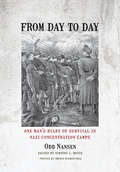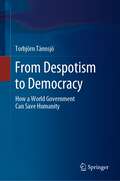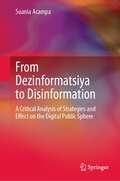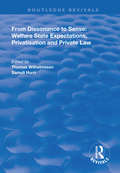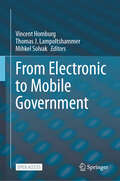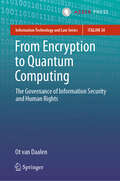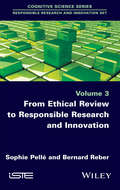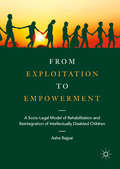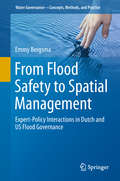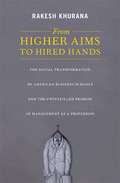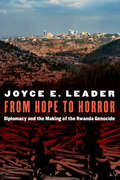- Table View
- List View
From Day to Day: One Man's Diary of Survival in Nazi Concentration Camps
by Odd Nansen Timothy J. BoyceIn 1942 Norwegian Odd Nansen was arrested by the Nazis, and he spent the remainder of World War II in concentration camps—Grini in Oslo, Veidal above the Arctic Circle, and Sachsenhausen in Germany. For three and a half years, Nansen kept a secret diary on tissue-paper-thin pages later smuggled out by various means, including inside the prisoners' hollowed-out breadboards.Unlike writers of retrospective Holocaust memoirs, Nansen recorded the mundane and horrific details of camp life as they happened, "from day to day." With an unsparing eye, Nansen described the casual brutality and random terror that was the fate of a camp prisoner. His entries reveal his constantly frustrated hopes for an early end to the war, his longing for his wife and children, his horror at the especially barbaric treatment reserved for Jews, and his disgust at the anti-Semitism of some of his fellow Norwegians. Nansen often confronted his German jailors with unusual outspokenness and sometimes with a sense of humor and absurdity that was not appreciated by his captors.After the Putnam's edition received rave reviews in 1949, the book fell into obscurity. In 1956, in response to a poll about the "most undeservedly neglected" book of the preceding quarter-century, Carl Sandburg singled out From Day to Day, calling it "an epic narrative," which took "its place among the great affirmations of the power of the human spirit to rise above terror, torture, and death." Indeed, Nansen witnessed all the horrors of the camps, yet still saw hope for the future. He sought reconciliation with the German people, even donating the proceeds of the German edition of his book to German refugee relief work. Nansen was following in the footsteps of his father, Fridtjof, an Arctic explorer and humanitarian who was awarded the Nobel Peace Prize in 1922 for his work on behalf of World War I refugees. (Fridtjof also created the "Nansen passport" for stateless persons.)This new edition, the first in over sixty-five years, contains extensive annotations and new diary selections never before translated into English. Forty sketches of camp life and death by Nansen, an architect and talented draftsman, provide a sense of immediacy and acute observation matched by the diary entries. The preface is written by Thomas Buergenthal, who was "Tommy," the ten-year-old survivor of the Auschwitz Death March, whom Nansen met at Sachsenhausen and saved using his extra food rations. Buergenthal, who later served as a judge on the International Court of Justice at The Hague, is a recipient of the 2015 Elie Wiesel Award from the US Holocaust Memorial Museum.
From Day to Day: One Man's Diary of Survival in Nazi Concentration Camps
by Odd NansenThis new hardcover edition of Odd Nansen's diary, the first in over sixty-five years, contains extensive annotations and other material not found in any other hardcover or paperback versions. Nansen, a Norwegian, was arrested in 1942 by the Nazis, and spent the remainder of World War II in concentration camps--Grini in Oslo, Veidal above the Arctic Circle, and Sachsenhausen in Germany. For three and a half years, Nansen kept a secret diary on tissue-paper-thin pages later smuggled out by various means, including inside the prisoners' hollowed-out breadboards. Unlike writers of retrospective Holocaust memoirs, Nansen recorded the mundane and horrific details of camp life as they happened, "from day to day." With an unsparing eye, Nansen described the casual brutality and random terror that was the fate of a camp prisoner. His entries reveal his constantly frustrated hopes for an early end to the war, his longing for his wife and children, his horror at the especially barbaric treatment reserved for Jews, and his disgust at the anti-Semitism of some of his fellow Norwegians. Nansen often confronted his German jailors with unusual outspokenness and sometimes with a sense of humor and absurdity that was not appreciated by his captors. After the Putnam's edition received rave reviews in 1949, the book fell into obscurity. In 1956, in response to a poll about the "most undeservedly neglected" book of the preceding quarter-century, Carl Sandburg singled out From Day to Day, calling it "an epic narrative," which took "its place among the great affirmations of the power of the human spirit to rise above terror, torture, and death." Indeed, Nansen witnessed all the horrors of the camps, yet still saw hope for the future. He sought reconciliation with the German people, even donating the proceeds of the German edition of his book to German refugee relief work. Nansen was following in the footsteps of his father, Fridtjof, an Arctic explorer and humanitarian who was awarded the Nobel Peace Prize in 1922 for his work on behalf of World War I refugees. (Fridtjof also created the "Nansen passport" for stateless persons.) Forty sketches of camp life and death by Nansen, an architect and talented draftsman, provide a sense of immediacy and acute observation matched by the diary entries. The preface is written by Thomas Buergenthal, who was "Tommy," the ten-year-old survivor of the Auschwitz Death March, whom Nansen met at Sachsenhausen and saved using his extra food rations. Buergenthal, author of A Lucky Child, formerly served as a judge on the International Court of Justice at The Hague and is a recipient of the 2015 Elie Wiesel Award from the US Holocaust Memorial Museum.
From Death Row to Freedom: The Struggle for Racial Justice in the Pitts-Lee Case
by Phillip A. HubbartAn insider’s account of a wrongful conviction and the fight to overturn it during the civil rights era This book is an insider’s account of the case of Freddie Pitts and Wilbert Lee, two Black men who were wrongfully charged and convicted of the murder of two white gas station attendants in Port St. Joe, Florida, in 1963, and sentenced to death. Phillip Hubbart, a defense lawyer for Pitts and Lee for more than 10 years, examines the crime, the trial, and the appeals with both a keen legal perspective and an awareness of the endemic racism that pervaded the case and obstructed justice. Hubbart discusses how the case against Pitts and Lee was based entirely on confessions obtained from the defendants and an alleged “eyewitness” through prolonged, violent interrogations and how local authorities repeatedly rejected later evidence pointing to the real killer, a white man well known to the Port St. Joe police. The book follows the case’s tortuous route through the Florida courts to the defendants’ eventual exoneration in 1975 by the Florida governor and cabinet. From Death Row to Freedom is a thorough chronicle of deep prejudice in the courts and brutality at the hands of police during the civil rights era of the 1960s. Hubbart argues that the Pitts-Lee case is a piece of American history that must be remembered, along with other similar incidents, in order for the country to make any progress toward racial reconciliation today. Publication of this work made possible by a Sustaining the Humanities through the American Rescue Plan grant from the National Endowment for the Humanities.
From Despotism to Democracy: How a World Government Can Save Humanity
by Torbjörn TännsjöThis book is about how best to respond to existential global threats posed by war and global heating. The stakes have become existential. A strong claim in the book is that we need a world state to save humanity. The book sheds new light on why this is so. The present author has long advocated global democracy. A strong argument against global democracy has been, however, that no state has ever been established without the resort to violence. In this book, the author bites the bullet and advocates a route to global democracy that passes through a phase where a global state is established in the form of global despotism. First despotism, then democracy! But, as the author insists and the reader will find, this is at most something we can hope for. We may fail. The moral importance of failure is thoroughly discussed.The book explored the following topics:· The tragedy of the commons is presented as the best explanation of why we do so little to obviate the causes behind climate change.· A world government presents a way out of the tragedy of the commons.· Standard arguments against a world state are examined.· The question of whether it matters if humanity goes extinct is taken seriously.· What if the attempt to establish a world state fails. The book is written by a philosopher, but the intended audience is broad. It has a place in courses in political philosophy, but it is possible for anyone who wants to do so to dig deeper into the questions should be able to read it. And regardless of whether you who read the book are a scholar or a layperson, there is no way for you to avoid its topic. Global existential issues concern all of us, regardless of profession or nationality.
From Dezinformatsiya to Disinformation: A Critical Analysis of Strategies and Effect on the Digital Public Sphere
by Suania AcampaThe book takes a critical look at the phenomenon of disinformation by identifying the historical, technological and human elements that contribute to the current success of disinformation strategies. The author examines the origin of the word "Dezinformatsiya", used by Russian planners in the 1950s, to understand how military strategy has transformed into militarization of information. The book pays particular attention to the power of algorithmic platforms on the selection and dissemination of digital content and their role in the spread of misinformation. This influences traditional editorial practices, disintermediating the production and distribution of news and amplifying a particular human cognitive mechanism: confirmation bias. The author investigates the Italian case to identify general archetypes, and typical and salient elements of disinformation strategies. The results offer a further interpretative aspect to studying disinformation, which represents a fracture in the digital public sphere, a kind of irrational object circulating in a space believed to be governed by rational engagement norms. The book conclusively shows how polarizing narratives used in disinformation strategies are the expression of complex ideological undergrowth embodied in extremes of the political spectrum. This highly topical book is for students and researchers from across the social sciences and media interested in the disinformation phenomenon.
From Dissonance to Sense: Welfare State Expectations, Privatisation and Private Law (Routledge Revivals)
by Thomas Wilhelmsson Samuli HurriFirst published in 1999, this book focuses on the new role of private law in late modernity. It analyses the pressures for changes in this area of law due to the present processes of privatisation and marketisation. The perspective is welfarist: in what ways and to what extent can the welfare state expectations of the citizens be defended through private law mechanisms when state-offered security is diminishing? Which alternatives are available when developing private law? The questions are discussed against the background of theories concerning important features of late modern society, for example consumerism, risk, information, globalisation and fragmentation. Several fields of private law are analysed, such as private law theory, tort and liability law, contract law and credit law as well as access to justice issues. The approach is comparative, including analyses of both common law and continental law.
From Electronic to Mobile Government
by Vincent Homburg Thomas J. Lampoltshammer Mihkel SolvakThe open access book combines insights from policy sciences (backgrounds of cross-border coordination challenges), design science (development of architectures for mobile services), information ethics (privacy and security of e-government services in international arenas) and business studies (changes in existing business models). The notably interdisciplinary character provides scholars and policy professionals working in specific (legal, political, engineering) disciplines a unique outlook on how policy making, implementation, and pilots are related in multi-level and cross-border governance. The book presents the results of the EU-funded “Mobile Cross-Border Government Services for Europe” (mGov4EU) project in which various pilots implemented and validated enhanced infrastructure services for electronic voting, smart mobility, and mobile signing. Together, the single pilots demonstrated how enhanced electronic identities and trust services (eIDAS) and Single Digital Gateway Regulation (SDGR) layers can accommodate once-only, digital-by-default and mobile-first principles. By taking advantage of security features of modern smartphones like hardware-backed secure elements together with integrated convenience elements like biometric sensors, this research showed how both the security needs and data-protection expectations one has into public services and the usability challenges that arise when accessing complex services using constrained mobile devices meet. This book is the first one in his kind to address this gap in the academic knowledge, as well as this gap in available compendiums for policy professionals at European levels of decision-making, as well as for policymakers and experts working on electronic identification, cross-border and cross-sector information exchange in the various member states of the European Union. This way, it serves various audiences: first, researchers in informatics-related areas like information systems, electronic government, and mobile applications, as it describes empirical examples of secure, easy-to-use and cross-border electronic services that have been developed and successfully tested in practice. Second, it also caters to researchers in international relations or political science as well as policymakers and politicians, both at national or European levels, who are involved in drafting policies and implementing European initiatives in relation to the building blocks of next-generation e-government services.
From Encryption to Quantum Computing: The Governance of Information Security and Human Rights (Information Technology and Law Series #38)
by Ot van DaalenThis book examines the implications of information security which plays such an important role in modern digital infrastructure. Information security technologies restrict the (mis)use of this infrastructure, while also constantly being probed by researchers, intelligence agencies and criminals. One can see this cycle of making and breaking everywhere in the digital sphere. An important example of this cat-and-mouse game is the development of quantum computers, which may in the near future break some widely used encryption technologies. This cycle also has implications for human rights: weakening encryption may affect privacy, for example. But the relationship between human rights and information security has not been investigated in-depth before. In this study, state obligations relating to information security are analysed under the European Convention for Human Rights and the EU Charter for Fundamental Rights, focusing on issues as human rights-compatible encryption policy, on how governments should deal with vulnerabilities in software, and whether governments can curtail the development and export of quantum computers. This book analyses the human rights-compatibility of quantum computing governance and offers unique insights into the connection between human rights and information security that will be relevant for legal practitioners, policy-makers and academics involved in this field of research. Ot van Daalen is Assistant Professor at the Institute for Information Law (IViR), Faculty of Law of the University of Amsterdam, the Netherlands.
From Enforcers to Guardians: A Public Health Primer on Ending Police Violence
by Mindy Thompson Fullilove Hannah L. CooperA public health approach to understanding and eliminating excessive police violence.Excessive police violence and its disproportionate targeting of minority communities has existed in the United States since police forces first formed in the colonial period. A personal tragedy for its victims, for the people who love them, and for their broader communities, excessive police violence is also a profound violation of human and civil rights.Most public discourse about excessive police violence focuses, understandably, on the horrors of civilian deaths. In From Enforcers to Guardians, Hannah L. F. Cooper and Mindy Thompson Fullilove approach the issue from a radically different angle: as a public health problem. By using a public health framing, this book challenges readers to recognize that the suffering created by excessive police violence extends far outside of death to include sexual, psychological, neglectful, and nonfatal physical violence as well.Arguing that excessive police violence has been deliberately used to marginalize working-class and minority communities, Cooper and Fullilove describe what we know about the history, distribution, and health impacts of police violence, from slave patrols in colonial times to war on drugs policing in the present-day United States. Finally, the book surveys efforts, including Barack Obama's 2015 creation of the Task Force on 21st Century Policing, to eliminate police violence, and proposes a multisystem, multilevel strategy to end marginality and police violence and to achieve guardian policing. Aimed at anyone seeking to understand the causes and distributions of excessive police violence—and to develop interventions to end it—From Enforcers to Guardians frames excessive police violence so that it can be understood, researched, and taught about through a public health lens.
From England to France
by William Chester JordanAt the height of the Middle Ages, a peculiar system of perpetual exile--or abjuration--flourished in western Europe. It was a judicial form of exile, not political or religious, and it was meted out to felons for crimes deserving of severe corporal punishment or death. From England to France explores the lives of these men and women who were condemned to abjure the English realm, and draws on their unique experiences to shed light on a medieval legal tradition until now very poorly understood.William Chester Jordan weaves a breathtaking historical tapestry, examining the judicial and administrative processes that led to the abjuration of more than seventy-five thousand English subjects, and recounting the astonishing journeys of the exiles themselves. Some were innocents caught up in tragic circumstances, but many were hardened criminals. Almost every English exile departed from the port of Dover, many bound for the same French village, a place called Wissant. Jordan vividly describes what happened when the felons got there, and tells the stories of the few who managed to return to England, either illegally or through pardons.From England to France provides new insights into a fundamental pillar of medieval English law and shows how it collapsed amid the bloodshed of the Hundred Years' War.
From Environmental to Comprehensive Security
by Arthur H. WestingThis work presents the evolution of the traditional concept of "national security" as military security to additionally embrace "environmental security" and then necessarily also "social (societal) security", thence to be termed "comprehensive human security". It accomplishes this primarily by presenting 11 of the author's own benchmark papers published between 1983 and 2010 (additionally providing bibliographic citations to a further 36 of the author's related publications during that period). The work stresses the importance of transfrontier (regional) cooperation, and also recognizes global overpopulation as a key impediment to achieving comprehensive human security.
From Environmental to Ecological Law (Routledge Explorations in Environmental Studies)
by Kirsten Anker; Peter D. Burdon; Geoffrey Garver; Michelle Maloney; Carla SbertThis book increases the visibility, clarity and understanding of ecological law. Ecological law is emerging as a field of law founded on systems thinking and the need to integrate ecological limits, such as planetary boundaries, into law. Presenting new thinking in the field, this book focuses on problem areas of contemporary law including environmental law, property law, trusts, legal theory and First Nations law and explains how ecological law provides solutions. Written by ecological law experts, it does this by 1) providing an overview of shortcomings of environmental law and other areas of contemporary law, 2) presenting specific examples of these shortcomings, 3) explaining what ecological law is and how it provides solutions to the shortcomings of contemporary law, and 4) showing how society can overcome some key challenges in the transition to ecological law. Drawing on a diverse range of case study examples including Indigenous law, ecological restoration and mining, this volume will be of great interest to students, scholars and policymakers of environmental and ecological law and governance, political science, environmental ethics and ecological and degrowth economics.
From Ethical Review to Responsible Research and Innovation
by Bernard Reber Sophie PelléThe concept of RRI has emerged as a new framework to be used by the European Commission for research projects. It now lies at the core of the Horizon 2020 programme and is designed to replace current assessment practices focused on ethical review. The book will analyse the shift from ethical review to RRI: what remains of the former, what has been gained? Secondly, it makes a critical presentation of existing ethical reviews from the perspectives of moral philosophy and the philosophy of technology. It discusses conceptions of ethical assessment on different levels. Thirdly, this book presents the RRI pillars presented by the European commission, together with their possible relationships to different governance models. Moreover, existing academic literature on RRI, which is not yet extensive, is growing rapidly. Various frameworks highlighting the dimensions of and conditions for responsible research and innovation have been proposed to define RRI. However, in spite of a well-established tradition on the subject in moral theory and philosophy, none of these approaches has investigated the concept of responsibility in depth. Fourthly, and for this reason, the book will provide an analysis of various meanings of responsibility that have been identified in moral theory and will discuss their relevance for RRI in different contexts. It will defend a pluralist approach to responsibility and explore several combinations of responsibilities depending on how these responsibilities are shared in a given context. The book adopts both a theoretical and a practical approach by assessing different participatory devices and analysing a number of research cases.
From Exploitation to Empowerment: A Socio-Legal Model of Rehabilitation and Reintegration of Intellectually Disabled Children
by Asha BajpaiThis book presents the outcomes of a field action project at the Tata Institute of Social Sciences (TISS). Project Chunauti (English translation: Project Challenge) focused on a group of intellectually disabled, orphan children who were survivors of abuse, exploitation and neglect, and describes their journey toward empowerment. It offers a vision and a reproducible, adaptable model for rehabilitation that can foster the social re-integration of intellectually disabled orphans at institutions. As the implementation of laws is especially important for vulnerable groups, the book also outlines a socio-legal approach that not only impacts the children directly, but can also bring about policy level reforms.Project Chunauti was born out of the need to explore options for these children and to set standards for their care, protection, rehabilitation and social re-integration. The core objectives of the project were to provide support and services, including counseling, education, life skills and vocational skills training, as well as medical and psychiatric support to help them overcome the trauma of abuse and exploitation. Its further goal was to train the staff of state-run homes and state authorities, helping them prepare and implement care plans and rehabilitation, combat child sexual abuse and malnutrition, employ positive disciplining, and better understand disabilities. The book also draws on the Project team’s experiences of rolling out the replication process in Maharashtra. This book highlights the role of the courts, media and other stakeholders in the journey towards empowerment and justice. It is a combination of social-work methods, application and implementation of law and legal advocacy, as well as best practices for protecting children’s rights and developing rehabilitation and re-integration projects for intellectually disabled, orphaned children in India. The interventions detailed here provide a reproducible, adaptable model of intervention for children in institutional care across the country.
From Flood Safety to Spatial Management: Expert-Policy Interactions in Dutch and US Flood Governance (Water Governance - Concepts, Methods, and Practice)
by Emmy BergsmaThis book deals with the introduction of a new type of “spatial measures" in flood governance. In contrast to traditional “safety measures" that aim to provide protection against floods by building structural flood defenses such as levees and flood walls, the goal of spatial measures is to reduce the exposure to flood risks by changing the spatial layout of flood-prone areas. By limiting developments and flood-proofing buildings in areas at risk to flooding, investments in structural flood defenses can be circumvented and vulnerabilities reduce. World-wide, spatial measures are gaining attractiveness as a response strategy to increasing flood risks caused by climate change and urbanization. The introduction of spatial measures in flood governance involves more than the simple development of new policies and laws. Research has demonstrated that the implementation of spatial measures can have huge implications for how costs and responsibilities are divided between different levels of governance and between public and private actors, changing the whole organization behind flood governance. Both for the effectiveness and for the legitimacy of spatial flood governance strategies, it is important that these distributive implications are well understood. This book describes the introduction of spatial measures in the context of two very different delta countries: the Netherlands and the United States. In the United States, a spatial flood governance strategy was already developed in de mid-20th century whereas in the Netherlands, a safety paradigm institutionalized over the course of the 20th century and spatial measures have only recently been introduced. By analyzing the science-policy interactions underlying the implementation of spatial measures in both countries, this book shows how under the influence of different types of experts (engineers in the Netherlands and social geographers in the United States) different spatial flood management strategies emerged with different distributive implications, each with its own challenges for effectiveness and legitimacy.
From Formalism to Weak Form: The Architecture and Philosophy of Peter Eisenman
by Stefano CorboPeter Eisenman is one of the most controversial protagonists of the architectural scene, who is known as much for his theoretical essays as he is for his architecture. While much has been written about his built works and his philosophies, most books focus on one or the other aspect. By structuring this volume around the concept of form, Stefano Corbo links together Eisenman’s architecture with his theory. From Formalism to Weak Form: The Architecture and Philosophy of Peter Eisenman argues that form is the sphere of mediation between our body, our inner world and the exterior world and, as such, it enables connections to be made between philosophy and architecture. From the start of his career on, Eisenman has been deeply interested in the problem of form in architecture and has constantly challenged the classical concept of it. For him, form is not simply a cognitive tool that determines a physical structure, which discriminates all that is active from what is passive, what is inside from what is outside. He has always tried to connect his own work with the cultural manifestations of the time: firstly under the influence of Colin Rowe and his formalist studies; secondly, by re-interpreting Chomsky’s linguistic theories; in the 80’s, by collaborating with Derrida and his de-constructivist approach; more recently,by discovering Henri Bergson's idea of Time. These different moments underline different phases, different projects, different programmatic manifestos; and above all, an evolving notion of form. Taking a multi-disciplinary approach based on the intersections between architecture and philosophy, this book investigates all these definitions and, in doing so, provides new insights into and a deeper understanding of the complexity of Eisenman’s work.
From Good Will to Civil Rights: Transforming Federal Disability Policy
by Richard K. ScotchDescribes how America's disabled mobilized to effect changes in public policy, not once but twice, and it suggests that the struggle is not yet over. This book surveys the effects and disappointments associated with the Americans with Disabilities Act, passed in 1990, in the context of the movement to secure full civil rights for disabled people.
From Goods to a Good Life: Intellectual Property and Global Justice
by Madhavi SunderMost scholarship on intellectual property considers this law from the standpoint of law and economics. Under this conventional wisdom, intellectual property is simply a tool for promoting innovative products, from iPods to R2D2. In this highly original book Madhavi Sunder calls for a richer understanding of intellectual property law's effects on social and cultural life. Intellectual property does more than incentivize the production of more goods. This law fundamentally affects the ability of citizens to live a good life. Intellectual property law governs the abilities of human beings to make and share culture, and to profit from this enterprise in a global Knowledge economy. This book turns to social and cultural theory to more fully explore the deep connections between cultural production and human freedom.
From Hello to Goodbye: Proactive Tips for Maintaining Positive Employee Relations
by Christine V. WaltersUnderstanding the full scope of the employee experience - from entry to exit - strengthens HR's impact and mitigates risk. Evaluating the complete employment relationship in reverse - from departure through hire - From Hello to Goodbye is the HR professional's complete guide to understanding the various ways business relationships end, managing disability and leave issues, properly classifying workers, maintaining an inclusive workplace, increasing retention and avoiding litigation.This updated second edition incorporates new legal developments, best practices and compliance requirements while offering practical advice on managing emotional reactions, making the case for inclusion and addressing workplace safety.A trusted resource for HR professionals, the book blends legal insight with hands-on tips to support both people and organizational health.
From Heritage to Terrorism: Regulating Tourism in an Age of Uncertainty
by Brian Simpson Cheryl SimpsonCritical in style, From Heritage to Terrorism: Regulating Tourism in an Age of Uncertainty examines the law and its role in shaping and defining tourism and the tourist experience. Using a broad range of legal documents and other materials from a variety of disciplines, it surveys how the underlying values of tourism often conflict with a concern for human rights, cultural heritage and sustainable environments. Departing from the view that within this context the law is simply relegated to dealing the ‘hard edges’ of the tourist industry and tourist behaviour, the authors explore: the ways that the law shapes the nature of tourism and how it can do this the need for a more focused role for law in tourism the law’s current and potential role in dealing with the various tensions for tourism in the panic created by the spread of global terrorism. Addressing a range of fundamental issues underlying global conflict and tourism, this thoroughly up-to-date and topical book is an essential read for all those interested in tourism and law.
From Higher Aims to Hired Hands: The Social Transformation of American Business Schools and the Unfulfilled Promise of Management as a Profession
by Rakesh Khurana"I have been waiting for years for someone to write the definitive institutional history of U. S. management education, and this is it. From the standpoint of most analytic definitions of 'professional,'the term 'professional manager' is enigmatic, even oxymoronic. Rakesh Khurana's thorough, insightful, provocative, and courageous history of business education explains how this term came to make practical and cultural sense to a generation of Americans, and how its logic has been undermined in the past thirty years. "From Higher Aims to Hired Hands" is an exemplary work of institutional analysis, combining first-rate historiography with outstanding social-science scholarship. It will be essential reading for business historians, students of management and organizations, and faculty, administrators, and thoughtful students at America's business schools. "--Paul DiMaggio, Princeton University" "From Higher Aims to Hired Hands" is a tour de force. With profound depth and sweeping scope, Rakesh Khurana analyses the rise and potential fall of a uniquely American institution--one that has influenced management education throughout the world. His book contributes significantly to explaining how managerial capitalism could go awry and how to restore the moral underpinnings that would make management the profession of leadership. In addition to offering fascinating history lessons based on exhaustive research, Khurana adds new twists to institutional theory and points to future directions for educational practice. "--Rosabeth Moss Kanter, Harvard Business School, author of "The Change Masters, Confidence," and "America the Principled: 6 Opportunities for Becoming a Can-Do Nation OnceAgain" "This panoramic portrait of the origins and ramifications of American business education is quite remarkable, rich in detail, powerful in the marshaling of evidence, and provocative in its claims. Khurana writes with confidence, authority, and erudition. "--Walter Powell, Stanford University "This is a wonderful and important book for anyone interested in business education. There is a tendency for those of us involved in business education to think that we understand the dynamics of our industry and that there is little new that we can learn. How wrong such a judgment would be. In providing a sociological understanding of the origins of business education and the professionalization of management, this book prompts deep reflection about the state of management today and offers real insight into the challenges of elevating the standards of this particular profession. "--Joel Podolny, dean of Yale School of Management
From Higher Aims to Hired Hands: The Social Transformation of American Business Schools and the Unfulfilled Promise of Management as a Profession
by Rakesh KhuranaIs management a profession? Should it be? Can it be? This major work of social and intellectual history reveals how such questions have driven business education and shaped American management and society for more than a century. The book is also a call for reform. Rakesh Khurana shows that university-based business schools were founded to train a professional class of managers in the mold of doctors and lawyers but have effectively retreated from that goal, leaving a gaping moral hole at the center of business education and perhaps in management itself. Khurana begins in the late nineteenth century, when members of an emerging managerial elite, seeking social status to match the wealth and power they had accrued, began working with major universities to establish graduate business education programs paralleling those for medicine and law. Constituting business as a profession, however, required codifying the knowledge relevant for practitioners and developing enforceable standards of conduct. Khurana, drawing on a rich set of archival material from business schools, foundations, and academic associations, traces how business educators confronted these challenges with varying strategies during the Progressive era and the Depression, the postwar boom years, and recent decades of freewheeling capitalism. Today, Khurana argues, business schools have largely capitulated in the battle for professionalism and have become merely purveyors of a product, the MBA, with students treated as consumers. Professional and moral ideals that once animated and inspired business schools have been conquered by a perspective that managers are merely agents of shareholders, beholden only to the cause of share profits. According to Khurana, we should not thus be surprised at the rise of corporate malfeasance. The time has come, he concludes, to rejuvenate intellectually and morally the training of our future business leaders.
From Hire to Liar: The Role of Deception in the Workplace
by David ShulmanThis book offers a sociological study of the rationales for, and methods of, workplace deception. The author begins by presenting an ethnographic analysis of private detectives' routine use of deception as an officially-sanctioned component of their work. He then uses interviews and case-studies to show how similar strategies are used in a variety of other work environments. The author discusses the justification and effects of workplace deception on both workers and employers.
From Hope to Horror: Diplomacy and the Making of the Rwanda Genocide
by Joyce E. LeaderAs deputy to the U.S. ambassador in Rwanda, Joyce E. Leader witnessed the tumultuous prelude to genocide—a period of political wrangling, human rights abuses, and many levels of ominous, ever-escalating violence. From Hope to Horror offers her insider&’s account of the nation&’s efforts to move toward democracy and peace and analyzes the challenges of conducting diplomacy in settings prone to—or engaged in—armed conflict. Leader traces the three-way struggle for control among Rwanda&’s ethnic and regional factions. Each sought to shape democratization and peacemaking to its own advantage. The United States, hoping to encourage a peaceful transition, midwifed negotiations toward an accord. The result: a revolutionary blueprint for political and military power-sharing among Rwanda&’s competing factions that met categorical rejection by the &“losers&” and a downward spiral into mass atrocities. Drawing on the Rwandan experience, Leader proposes ways diplomacy can more effectively avert the escalation of violence by identifying the unintended consequences of policies and emphasizing conflict prevention over crisis response. Compelling and expert, From Hope to Horror fills in the forgotten history of the diplomats who tried but failed to prevent a human rights catastrophe.
From Human Dignity To Natural Law: An Introduction
by Richard Berquist Steven J. JensenFrom Human Dignity to Natural Law shows how the whole of the natural law, as understood in the Aristotelian Thomistic tradition, is contained implicitly in human dignity. Human dignity means existing for one's own good (the common good as well as one's individual good), and not as a mere means to an alien good. But what is the true human good? This question is answered with a careful analysis of Aristotle's definition of happiness. The natural law can then be understood as the precepts that guide us in achieving happiness. To show that human dignity is a reality in the nature of things and not a mere human invention, it is necessary to show that human beings exist by nature for the achievement of the properly human good in which happiness is found. This implies finality in nature. Since contemporary natural science does not recognize final causality, the book explains why living things, as least, must exist for a purpose and why the scientific method, as currently understood, is not able to deal with this question. These reflections will also enable us to respond to a common criticism of natural law theory: that it attempts to derive statements of what ought to be from statements about what is.
